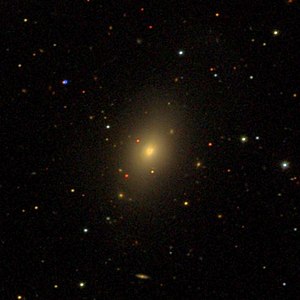NGC 6021
| Galaxy NGC 6021 |
|
|---|---|

|
|
| SDSS recording | |
| AladinLite | |
| Constellation | Snake |
|
Position equinox : J2000.0 , epoch : J2000.0 |
|
| Right ascension | 15 h 57 m 30.7 s |
| declination | + 15 ° 57 ′ 22 ″ |
| Appearance | |
| Morphological type | E4 |
| Brightness (visual) | 13.1 mag |
| Brightness (B-band) | 14.1 mag |
| Angular expansion | 1.4 ′ × 0.8 ′ |
| Position angle | 160 ° |
| Surface brightness | 13.3 mag / arcmin² |
| Physical data | |
| Redshift | 0.015818 ± 0.000070 |
| Radial velocity | (4742 ± 21) km / s |
|
Stroke distance v rad / H 0 |
(216 ± 15) · 10 6 ly (66.2 ± 4.6) Mpc |
| history | |
| discovery | Wilhelm Herschel |
| Discovery date | March 21, 1784 |
| Catalog names | |
| NGC 6021 • UGC 10102 • PGC 56482 • CGCG 108-017 • MCG + 03-41-05 • GC 4152 • H III 73 • h 1943 • | |
NGC 6021 is a 13.1 likes bright elliptical galaxy from the Hubble type E4 in the constellation snake and about 216 million light-years from the Milky Way center.
Together with NGC 6018, it forms an optical double galaxy and was discovered on March 21, 1784 by Wilhelm Herschel with an 18.7-inch reflector telescope, who described it as "eF, vS, easily verified with 240 power".
